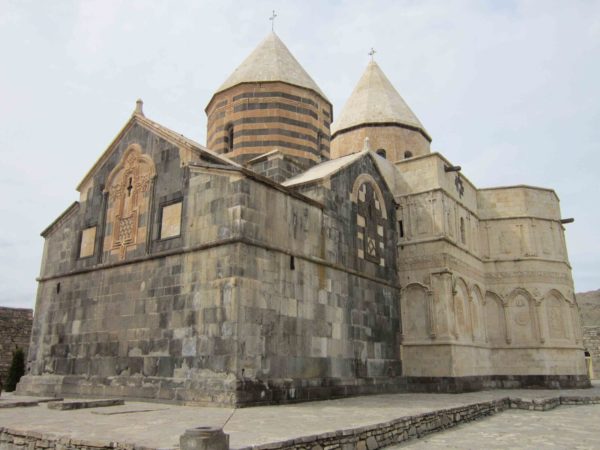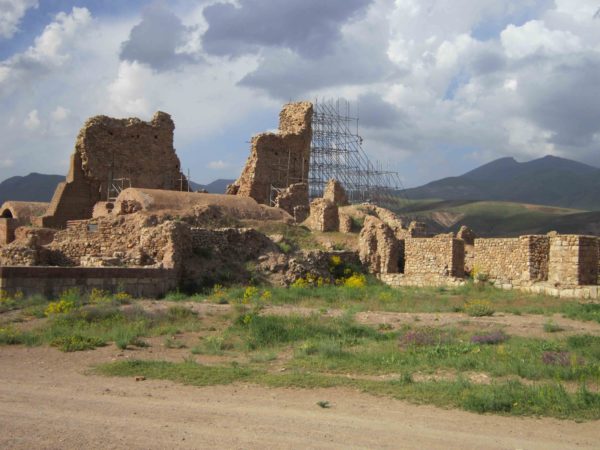Orumiyeh (Urmia, Urumiyeh) was kown as Rezayeh during the Pahlavi era. It is a logical stop en route to southeastern Turkey. Orumiyeh is a large and historic city. The name Orumiyeh consists of the Assyrian words ‘Ur’ meaning ‘city’ and ‘Mia’ meaning ‘water,’ winning it the nickname ‘city of water.’ During the Pahlavi era (1925-1979), Reza Shah (1878-1944) changed the city’s name to Rezaieh but its name was changed back to Orumiyeh after the 1979 Islamic Revolution in Iran.
Excavations at Tepe Hassanlou archaeological site southwest of Lake Orumiyeh have found that this area was continuously inhabited from the 6th millennium BC to the 3rd century CE. However, Orumiyeh as a city is believed to have a 3 to 4,000-year history.
Orumiyeh is a city where different ethnicity and religions have lived alongside one another in harmony for centuries. The city has considerable Assyrian, Kurdish, and Armenian communities.
Friday Mosque:
Of the most important buildings of the town worth visiting, first of all we could mention the Friday Mosque (Masjid-e Jomeh or Masjid-e Jame) dating from Seljuk times, 13th century AD (with later restorations), and located inside bazaar; however, it is thought to incorporate an earlier structure. The vaulting of the cupola and the spacious prayer.
Seh Gonbad:
Not far from the Friday Mosque is the funerary tower called Seh Gonbad, or Three Cupolas in Pasdaran Avenue. This circular brick tower is a 12th century AD construction with a crypt in the lower part and a portal decorated with superb designs. Three inscription friezes carved on stone in Kuffic style, can still be seen at the entrance of the monument, and the date given at the end of the inscription is the month of Moharram in Hijrah year 580 (1184 AD).
Bazaar:
Orumiyeh has a lively covered bazaar which, though considerably later in date than the Isfahan bazaar, is built upon the same traditional lines. The domed vaults have circular openings to provide light, but they also let in rain and cold so that the tendency today is to cover them with glass. Actually, the bazaar consists of a network of smaller bazaars: grocers, goldsmiths, cloth dealers, copper smiths, shoemakers, felt makers, dyers, tinsmiths and knife makers. The absence of motor traffic adds greatly to the attraction of these old bazaars.
Orumiyeh Museum:
Orumiyeh Museum with an area of 750 square meters, consists of two halls, one larger than the other. It is located at Shahid Dr. Beheshti Avenue, where you can see archaeological and ethnological objects from the earliest prehistoric, pre Islamic and Islamic eras, as well as national art relics.
Maku:
When travelling on road from Tabriz to Orumiyeh, instead of bearing left to Khoi, if you continue on the road to Bazargan and Turkey, you will come to Maku (22 km from Turkey) from which several Armenian churches of the eleventh and twelfth centuries may be visited. Maku, straggling along either side of a mountain gorge at an altitude of 1,634 m above sea level, is the place where travelers following the main highway into Turkey bid farewell to civilization until Erzerum, 324 km to the west.
Baqeheh Juq Palace-Museum:
This historical two-storied palace stands in the center of a spacious garden covering 11 hectares. The building, dating back from the late Qajar period, was built by the orders of Eqbal os-Saltaneh Makuei, a military commander of Muzaffar od-Din Shah Qajar. After renovation, other structures were added to the building by his son. The architecture of this palace is a combination of Iranian and European styles (particularly the 19th century Russian architectural style). It was dwelt in by the family of Sardar-e Makuei until 1974, when it was purchased by the former Ministry of Culture and Art. After the victory of the Islamic Revolution it has been opened to visitors since 1979. Objects on exhibition include precious items such as carpets, furniture, chandeliers, textiles, etc.
Kara Kelisa:
The Armenian Church and Monastery of St. Thaddeus, known also as Kelisa-ye Tatavus by the name of St. Tadi, and locally called Kara Kelisa (the Black Church) is situated in desolate, but Nowadays easily accessible, country about 18 km south of Maku. According to Armenian legend, the Apostle Thadeus (generally identified as St. Jude) reached here about 66 AD and built the worlds first church. Actually, little is known of Thaddeus, one of Christs disciples to whom there are only passing references in the Bible. According to the same legend, he and another disciple, Simon the Zealot, were later martyred and buried in the site of Iran's first church.
Takht-e Suleiman:
The ancient, historical fort Takht-e Suleiman occupies an area of 124,000 square meters and is one of Irans most important ancient monuments, comprising ruins dating back to the Sassanian, Ashkanian, and Moghul periods.
Located in a distance of 45 km to the north east of Takab district at an altitude of 2,400 meters, it consists of a majestic building about 20 meters high, erected on top of a hill, plus a strong stone battlement. One enters the monument through a large gate above which traces of an inscription in Kuffic style can be seen, which belong to the Moghul period and is indicative of repairs of the place in that period.
Tappeh Hasanlu:
This is a long-lived tell 85 km south of Orulieh and 12 km east of Naqadeh (itself a historic area with many relics of ancient civilization of Iran), excavated by Dyson from 1965 on. Actually, it consists of a 20-meter high central hill surrounded by a number of 15-meter high peripheral hills. Historical evidence indicate that the central hill formed the main edifice and the its citadel was a town with temples and administrative parts, the population of which resided on the encircling hills. Once can discern the general layout of the citadel and parts of the foundations of a ring wall. We can also identify two rooms with columns of which nothing remains except the stone bases and a clay pedestal. Nearby are two store rooms where large terra-cotta jars used for storing wine and funnels were discovered.
Finally,to visit Orumiyeh, please have a look on our tours.

